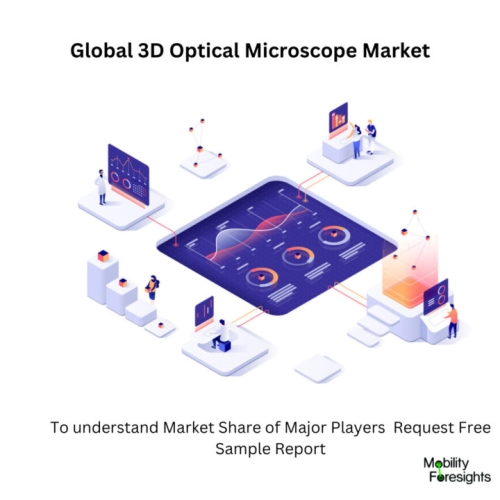
- Get in Touch with Us

Last Updated: Apr 26, 2025 | Study Period: 2024-2030
The 3D optical microscope is a cutting-edge imaging device that has completely changed how we view and assess tiny structures.
This cutting-edge technology enables the capture of three-dimensional data, in contrast to conventional microscopes that only produce 2D images, enabling a more thorough and precise comprehension of the specimens under research.
A method known as optical sectioning, which selectively focuses on particular depths within the sample, is the foundation of a 3D optical microscope.
Several techniques, including confocal microscopy, structured illumination, and light-sheet microscopy, are used to carry out this operation.
The microscope creates a high-resolution 3D model of the specimen by taking several images at various focus planes and then reconstructing them.
There are many advantages to 3D optical microscopy.
Complex biological tissues, microbes, and materials can be viewed by researchers and scientists with an unmatched level of clarity and depth.
Intricate spatial correlations can be uncovered by exploring samples in three dimensions, revealing important information that are normally buried in 2D photographs.
Additionally, the 3D optical microscope has uses in a number of industries, including biology, nanotechnology, materials research, and medicine.
It helps with understanding cellular functions, tissue organization, and developmental biology in biological research.
It enables the 3D evaluation of material surfaces and the research of their physical properties in materials science.
Medical experts can also use 3D optical microscopy to plan more precise diagnoses and treatments.

The Global 3d optical microscope market accounted for $XX Billion in 2023 and is anticipated to reach $XX Billion by 2030, registering a CAGR of XX% from 2024 to 2030.
ContourSP 3D Optical Microscope from Bruker is launched for the PCB Industry.
In comparison to previous generation SP models utilized by the semiconductor packaging industry, Bruker's ContourSP large panel metrology equipment more than doubles the measurement throughput of the high-density interconnect (HDI) substrates in multi-chip modules (MCM).
The gage-capable ContourSP, which was created specifically to measure each layer of printed circuit board (PCB) panels during manufacturing, ensures the shortest recipe development time, best yield, longest up-time, and lowest cost per measured panel in production.
Numerous top HDI/MCM PCB manufacturers have already placed over million in orders as a result of these features.
| Sl no | Topic |
| 1 | Market Segmentation |
| 2 | Scope of the report |
| 3 | Abbreviations |
| 4 | Research Methodology |
| 5 | Executive Summary |
| 6 | Introduction |
| 7 | Insights from Industry stakeholders |
| 8 | Cost breakdown of Product by sub-components and average profit margin |
| 9 | Disruptive innovation in the Industry |
| 10 | Technology trends in the Industry |
| 11 | Consumer trends in the industry |
| 12 | Recent Production Milestones |
| 13 | Component Manufacturing in US, EU and China |
| 14 | COVID-19 impact on overall market |
| 15 | COVID-19 impact on Production of components |
| 16 | COVID-19 impact on Point of sale |
| 17 | Market Segmentation, Dynamics and Forecast by Geography, 2024-2030 |
| 18 | Market Segmentation, Dynamics and Forecast by Product Type, 2024-2030 |
| 19 | Market Segmentation, Dynamics and Forecast by Application, 2024-2030 |
| 20 | Market Segmentation, Dynamics and Forecast by End use, 2024-2030 |
| 21 | Product installation rate by OEM, 2023 |
| 22 | Incline/Decline in Average B-2-B selling price in past 5 years |
| 23 | Competition from substitute products |
| 24 | Gross margin and average profitability of suppliers |
| 25 | New product development in past 12 months |
| 26 | M&A in past 12 months |
| 27 | Growth strategy of leading players |
| 28 | Market share of vendors, 2023 |
| 29 | Company Profiles |
| 30 | Unmet needs and opportunity for new suppliers |
| 31 | Conclusion |
| 32 | Appendix |